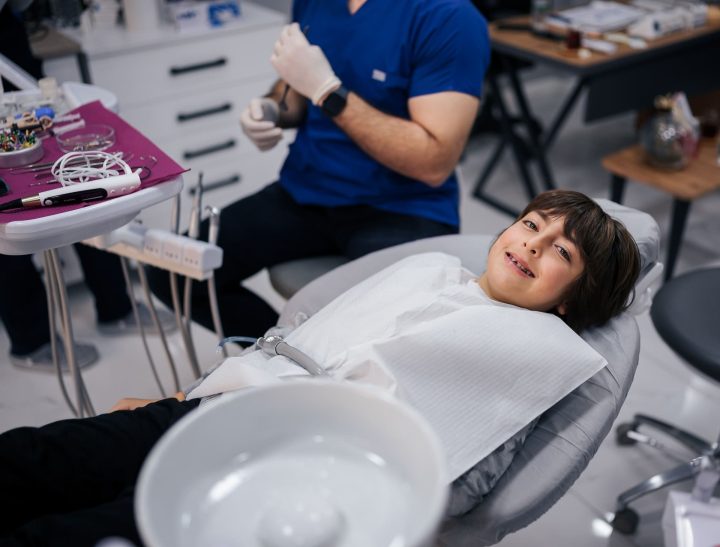With advancements in the field of orthodontics, dentists and orthodontists can now identify and address potential orthodontic issues in children at an early age, promoting a lifetime of optimal oral health and confidence. Interceptive orthodontics, also known as Phase I or early orthodontic treatment, refers to orthodontic intervention during a child’s growth and development stages, often between the ages of 6 and 10.
Interceptive orthodontics focuses on identifying and correcting orthodontic issues before they become more severe, setting the foundation for a healthy, aligned, and beautiful smile. This approach typically involves addressing dental concerns like crowding, crossbites, overbites, and jaw growth discrepancies during the mixed dentition stage when both primary and permanent teeth are present in the child’s mouth. By intervening early, orthodontic treatment can be more effective, less invasive, and often completed in less time – ultimately improving a child’s self-esteem and dental health in the long run.
The American Association of Orthodontists recommends children have their first orthodontic assessment by the age of 7, as this is when the first permanent molars erupt, and an orthodontist can analyze the relationships between teeth and jaws effectively. Not every child will require interceptive orthodontics, and early evaluations help determine who may benefit from this proactive approach and customize treatment plans accordingly.
At Waban Dental Group – Pediatric Dentistry & Orthodontic, we understand the importance of proactive dental care for your child and aim to provide comprehensive information on various dental services that contribute to your family’s well-being. In this article, we will discuss the significance of interceptive orthodontics, its benefits, and how incorporating this treatment modality can improve your child’s overall dental health and smile aesthetics.
Benefits of Interceptive Orthodontics for Children
1. Early Detection of Orthodontic Issues
Interceptive orthodontics enables dental professionals to identify and assess dental issues during a child’s growth and development stages. By detecting potential problems early, dentists and orthodontists can customize treatment plans and take proactive measures to prevent more severe complications later in life.
2. Simplified and Shortened Treatment Time
By addressing orthodontic concerns in their early stages, interceptive orthodontics can simplify the treatment process and reduce the need for more invasive procedures in the future. This approach can also shorten the overall treatment time, making it more convenient and efficient for both the child and their family.
3. Cost-Effective Solutions
Interceptive orthodontics can be a more cost-effective solution compared to traditional orthodontic treatments. By addressing issues early on, parents may avoid costly procedures, such as tooth extractions or jaw surgery, that might be necessary if dental concerns were left untreated until their child’s teenage years.
4. Boosted Self-Esteem and Confidence
The impact of healthy, well-aligned teeth on a child’s self-esteem cannot be underestimated. By addressing orthodontic concerns early on, interceptive orthodontics can help boost a child’s confidence and alleviate any social anxiety caused by dental imperfections.
Common Orthodontic Issues Addressed by Interceptive Orthodontics
1. Crowding
Crowding is one of the most common orthodontic problems in children. It occurs when there is not enough space in the dental arch to accommodate all permanent teeth. Interceptive orthodontics can help alleviate crowding by monitoring and guiding the eruption of permanent teeth or, when needed, employing growth modification appliances during growth spurts to correct jaw discrepancies.
2. Crossbites
A crossbite occurs when one or more upper teeth bite inside the lower teeth instead of outside, leading to misaligned teeth and potential jaw growth issues. Interceptive orthodontics can correct crossbites early on by using orthodontic appliances such as expanders to widen the upper jaw and create proper alignment.
3. Overbites
An overbite, when the upper teeth protrude over the lower teeth, can lead to various dental problems if left untreated. Interceptive orthodontics can help manage overbites in children by guiding jaw growth and monitoring tooth eruption to minimize or eliminate the need for future treatments.
4. Jaw Growth Discrepancies
Misalignments in the jaw can result in various orthodontic problems, affecting both dental health and overall facial aesthetics. Interceptive orthodontics can address jaw growth discrepancies, which may be caused by genetic factors or habits such as thumb-sucking, by using growth modification appliances to guide proper growth and development.
How Interceptive Orthodontics Works
Interceptive orthodontics often comprises two phases: the active phase and the passive phase. The active phase includes the use of orthodontic appliances like expanders, functional appliances, or partial braces, guiding the growth and positioning of teeth during the mixed dentition stage. The passive phase, or Phase II orthodontic treatment, usually occurs during adolescence and consists of comprehensive orthodontic care, typically full braces or aligners, to fine-tune the final tooth positioning and establish a stable bite.
Conclusion
Interceptive orthodontics serves as a preventive and proactive approach to addressing dental concerns in children, promoting a lifetime of optimal oral health and confidence. By identifying and treating orthodontic issues early, interceptive orthodontics offers numerous benefits, including simplified treatments, cost-effective solutions, and improved self-esteem for your child.
At Waban Dental Group – Pediatric Dentistry & Orthodontic, we are committed to fostering a foundation of healthy dental habits and prioritizing your family’s overall well-being. If you would like to learn more about interceptive orthodontics or evaluate its suitability for your child, do not hesitate to contact us now. Our experienced pediatric dentists in Amherst will provide you with the guidance and support your child needs for a lifetime of healthy, beautiful smiles.









